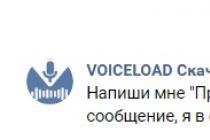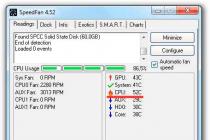Prior to the Galaxy S8, Samsung had already practiced the release of smartphones of one model with two types of processors ( Galaxy Note 7). The US market was supplied with devices based on the Snapdragon chip, and the European and Russian market- based on proprietary Exynos processors. Therefore, the news about the choice of two processor models at once for Samsung smartphone The Galaxy S8 looks quite believable.
Update from 03/30/2017. Five-Inches has published an overview of key Galaxy characteristics S8. Link to article Also on the site there is a report on the presentation, in which we talk about the main chips of the smartphone:.
Samsung Galaxy S8 - Latest Snapdragon 835 News
According to a tweet from the official Qualcomm account, the presentation of the Snapdragon 835 will take place at CES 2017. From now on, it will be possible to get acquainted with the real performance of this chipset. However, an insider on the topic of processor characteristics Samsung Galaxy The S8 lets you talk about the capabilities of the Snapdragon 835 before the start of CES 2017. Some specs go against the previously published data.
In particular, it is reported that Snapdragon 835 will be assembled on the basis of fast and slow cores. Moreover, the "high-speed" part of the chipset, which is responsible for heavy applications and 3D graphics, will be able to operate at 3.0 GHz, while the "slow" unit will support 2.4 GHz. Before the publication of the insider about processors for the Galaxy S8 as operating frequency Snapdragon 835 was named at 2.2 GHz.
Samsung Galaxy S8: two Exynos 8895 processors
According to an insider source in new Samsung Galaxy S8 will use two Exynos 8895 processors. The first option - Exynos 8895M will be able to operate at frequencies of 2.5 and 1.7 GHz (fast Exynos M2 cores and slow Cortex A53). The second option - Exynos 8895V - will show less impressive frequency characteristics - 2.3 and 1.7 GHz. However, both the "M" and "V" variants will be equipped with powerful graphics accelerators from the Mali-G71 family, so the 200 MHz difference will not be noticeable to amateurs. mobile games, nor to ordinary users.
S8 with Exynos 8895 or Snapdragon 835 processor: which to choose?
New publications
Editor's Choice!
In which flagship 2017 better screen? GSMArena offers a selection of 10 best smartphones 2017 with display specifications, unique features and key benefits!
Xiaomi presented the first budget smartphones with widescreen display: Redmi 5 and Redmi 5 Plus. Design, features, technical characteristics of new products in our review.
Xiaomi Redmi 5A - the simplest of the family of smartphones Chinese brand. Specifications optimal for a low price tag. What will surprise and delight the fans' gadget?
On December 7, Huawei will unveil the Nova 2S. We have collected the main technical characteristics of the smartphone, as well as the images of the smartphone that appeared on the network before the official announcement!
Editor's Choice!
Review of the new Huawei Mate 10 Lite: is the smartphone worth the money? We show performance in tests, examples of photos, design.
After a series of defeats in the smartphone market, the HTC brand took a course of rehabilitation. In 2018, the company will introduce smartphones of the middle price segment, which, according to the president of HTC, will compete with the Chinese. Among them will be a smartphone with a dual camera.
Which version flagship Galaxy Does the S8 perform better in benchmarks? Is there a performance difference between the Galaxy S8 and the Galaxy S8 + with a single chip?
As in previous years, Samsung has released flagship smartphones in two configurations. A version with a proprietary Exynos 8895 chip with an updated graphics accelerator Mali-G71 is supplied to the international market. It is manufactured using a 10nm manufacturing process for higher performance and energy efficiency. In the USA and China, a variant with powerful processor from Qualcomm, also using a 10nm process technology.
On paper, both chipsets look very similar as they use the same technology. And this is really important, because users around the world cannot choose which version to buy. As tests show, there are still differences.
The Exynos 8895 and Snapdragon 835-based Galaxy S8 smartphones have passed several tests, including Vellamo Metal, a Qualcomm benchmark.
![]()
In GFXBench in the T-Rex test, the devices did not have any problems - both showed a result of 60 frames per second. But in Manhattan 3.1, the Exynos 8895 came out slightly ahead with 41 fps compared to the Snapdragon 835 with 35 fps.
In Geekbench, the Exynos 8895 chip scored 2008/6575 points in single-core and multi-core tests, and the Snapdragon 835 - 1840/6134 points. Although the gap is not very large, this does not mean that it is not statistically significant. But in Basemark OS II, Vellamo Browser and JetStream JavaScript is better Snapdragon 835 proved itself. It can be noted that this processor is suitable for those who care about high speed work of the Internet.
Interestingly, each chipset has its own advantages. While the Snapdragon 835 excels in site navigation, the Exynos 8895 offers better graphics performance.
It is also worth noting that the Exynos 8895 version is more energy efficient than the Snapdragon 835 version.
In theory, the Galaxy S8 and Galaxy S8 + on the Exynos 8895 should show the same results. After all, the devices have the same processors, volume random access memory and built-in storage, display resolution - the difference is in the display size.

However, the Galaxy S8 + turns out to be more productive than its younger brother. The reasons why this is happening remains to be seen.
Samsung will present 2 new devices Galaxy line
based on different processors: Snapdragon 835 and Exynos 8895... Qualcomm-powered gadgets are likely to hit the US market, while their Samsung-made cousins will be sold to all other countries. Will American users have some privileges? And won't devices with Snapdragon 835 be a kind of exclusive? Let's figure out what to expect from both options for devices, and which one will be more powerful.
The Geekbench website decided to check what gadgets equipped with different processors are capable of, and published data on testing the performance of variations of the Samsung Galaxy S8 +. Both processors have 8 cores, but the Snapdragon has a slightly higher clock speed: 1900 MHz versus 1690 MHz for Exynos. In single-core mode, the test showed that Exynos scores 1978 points, and Snapdragon 1929 points, despite the difference in frequency. In the mode of using multiple cores, the ratio of processor power was set at around 6375 and 6084 points, respectively. The mode when 1 core is used is considered more important in the assessment, since the overwhelming majority of applications on Android are not able to equally redistribute the load between the cores. 
Geekbench evaluates devices on 52 different characteristics. The Exynos 8895 turned out to be more productive in 35 of them. Consequently, the owners of the S8 equipped with it not only do not lose anything, but also find themselves in an even more advantageous position.

According to the results of the Geekbench test, the Exynos 8895 processor is placed in the highest position in the top of the most productive processors when testing devices in multi-core mode.
Rumor has it that Samsung plans to raise clock frequency Exynos 8895 up to 2500 MHz, and increase the number of cores to 10, which means a significant increase in the growth of device power. However, do not forget that these are only rumors, and the characteristics of the devices may differ from those stated. 
The eighth generation Galaxy S smartphones will be announced on March 29th. The technical characteristics of the devices are almost identical: the dimensions, screen diagonal dimensions (5.8 versus 6.2 inches), and the size of the battery (3000 versus 3500 mAh) remain different.
As you know, Samsung will release variants of the Galaxy S8 and Galaxy S8 + on two processors - Snapdragon 835 from Qualcomm and its own Exynos 8895. Most likely, devices with a Qualcomm chip will be sold in the US, and with Exynos in all other countries, including Russia ... How much will we lose? Or is Exynos better? Let's figure it out.
Test results of two variants of the Samsung Galaxy S8 + smartphone appeared on the Geekbench benchmark site - the first one is installed Qualcomm processor and in the other - the latest Samsung's own chip. It is worth noting that both of them are assembled at Samsung factories using the same 10-nanometer FinFET technology, moreover, the Korean company helped Qualcomm specialists and took part in the development of the Snapdragon 835. Who contributed more to the creation of this chipset is unknown, but obvious that the Snapdragon 835 and Exynos 8895 use similar solutions. Both processors are octa-core, but the Snapdragon runs at a higher clock speed - 1.9 GHz versus 1.69 GHz for the Exynos.

In the single-core Geekbench test, the Exynos 8895 won - it scored 1978 points, and the Snapdragon 835 - 1929. In the multi-core mode, the gap is even greater - 6375 against 6084 points in favor of the Samsung processor. Single-core mode is considered more important because most Android applications cannot fully distribute a process across multiple cores. Geekbench tests 52 device parameters. In 35 parameters, the Exynos 8895 turned out to be more productive, and the Snapdragon 835 was only 17 in each.

Geekbench puts the Exynos 8895-powered Galaxy S8 + as the number one multi-core smartphone. It is ahead of all other flagship smartphones, including the Google Pixel XL, LG G6 and Apple iPhone 7 Plus. Both versions of the Samsung smartphone managed to overtake the Huawei Mate 9 with a Kirin 960 processor. In single-core mode, the Exynos version of the Galaxy S8 + takes the second place - only the Apple iPhone 7 Plus is more productive than it.

According to rumors, Samsung is going to increase the clock speed of the Exynos 8895 to 2.5 GHz, as well as install two additional video processor cores in the Galaxy S8 and Galaxy S8 +, which means that the performance of these smartphones could be even higher. In addition, versions of these devices with six gigabytes of RAM instead of four will be released in China - their performance in synthetic benchmarks is likely to be record. However, it should be borne in mind that these are only preliminary figures measured on early versions of smartphones. Devices that go on sale may show different results.
The Galaxy S8 and Galaxy S8 + will be unveiled on March 29th. The filling of these devices will be the same, they differ only in size, screen diagonals (5.8 and 6.2 inches) and battery capacity (3000 and 3500 mAh).
Samsung after a self-igniting disaster Galaxy batteries Note 7 has tried to take into account all the mistakes and released really worthy flagship smartphones S8 and S8 +. They are very attractive and feature huge screens in fairly compact metal and glass finishes.

As expected, the company released two versions of the flagship: the standard Galaxy S8 received a 5.8-inch screen, while the larger S8 + received a 6.2-inch screen. Both will be available for pre-order on March 30, and will hit the market on April 21. In Russian retail, smartphones will arrive on April 28 at a price of 55 thousand rubles for the Galaxy S8 and 60 thousand rubles for the Galaxy S8 +. In the US, smartphones are offered in black, gray and silver colors, and in other markets also in gold and blue.
Perhaps it's worth starting from the screen. In the case of the Galaxy S8, we are talking about a 5.8-inch display with a resolution of 2960 × 1440 and a density of 570 dots per inch. The Samsung Galaxy S8 + is equipped with a 6.2-inch OLED screen with the same resolution and a pixel density of 529 ppi. Curiously, Samsung has followed LG's path with its flagship smartphone G6, and the screens of the S8 are not only curved to the edges, but also even narrower - they have an aspect ratio of 18.5: 9 (versus 18: 9 for the G6). So don't be so scared large diagonal... This is all done with the same purpose: the devices should have as large a screen as possible, with which you can operate with one hand.

The displays of the new smartphones are extended up and down as much as possible, and also bend to the edges - Samsung calls this an "infinite display". I even had to leave in the past the distinctive for Galaxy series the physical Home button in favor of the standard virtual buttons. The company logo at the top of the front side, which annoyed many, also disappeared. Samsung has worked on tactile feedback. In addition, even if virtual buttons hidden in some applications, the user can forcefully press the bottom of the screen to activate the Home button - quite conveniently.

By the way, as is the case with the LG G6, the corners of the screen are slightly rounded, which adds elegance and possibly increases the reliability of the display. Hopefully, all the innovations with the screen will not lead to serious problems when working with third party applications... However, Galaxy S is popular and powerful Android smartphones on the market, so the developers will surely quickly fix possible problems with compatibility.

As you might expect, Samsung has come up with the most advanced SoCs on the Android smartphone market. Depending on the region, the user will receive either Qualcomm or their own latest generation chip. In both cases, we are talking about powerful 8-core processors produced at the facilities of Samsung itself in compliance with the most advanced 10 nm standards today. The latter allows us to hope for good energy efficiency indicators.

Samsung decided not to shock the public with the amount of RAM of its smartphones, so the devices received 4 GB standard and quite sufficient for today's flagships. The volume of built-in flash memory is also familiar: 64 GB, supplemented by a slot for microSD memory cards. Autonomous work devices provide 3000 mAh batteries (in the case of the S8) and 3500 mAh batteries (S8 +). The company, of course, talks a lot about safety precautions and extensive battery testing, which are designed to eliminate the problems specific to the Note 7. There is support for fast charging, as well as both common wireless charging standards.

Both smartphones are equipped with a 12-megapixel rear camera with a system optical stabilization and an aperture from f / 1.7 - very similar to last year's Galaxy S7. Samsung promises that it has worked on the software so that the camera is more responsive, faster, and the quality of photos has improved. Added many software capabilities like emulating a low depth of field, manual settings and different modes serial shooting. It is curious that the S8 + did not receive a better quality or dual camera- except for the screen and battery capacity, both smartphones are identical. The front camera has a resolution of 8 megapixels, a lens with an aperture of f / 1.7 and, most importantly, autofocus support.

Because of physical button"Home" disappeared, Samsung had to move the fingerprint scanner to the back side near the camera - not a very convenient place, because the user will touch the lens more often. By the way, the S8 is almost entirely made of glass, but the fingerprints on the body are not as noticeable as, for example, on the LG G6.

Present USB-C ports and a 3.5mm headphone jack, NFC support and MST for Samsung Pay, IP68 water and dust resistant, LTE Cat.16 support, Bluetooth 5.0, Wi-Fi 802.11ac. The Galaxy S8 weighs 155 g and measures 148.9 x 68.1 x 8 mm, while the Galaxy S8 Plus weighs 173 g and measures 159.5 x 73.4 x 8.1 mm. Installed modified Android version 7.0 Nougat.


The iris scanner that was introduced in the Note 7 is back in the S8. But there is also a more convenient way to unlock smartphones - new system definitions of persons. It takes literally 20 seconds to configure it, after which it works quite reliably. This is not the dubious built-in face unlock feature that was introduced in Android a few years ago, but a brand new one. Samsung technology which, it is said, is almost never wrong. True, it was not possible to check the operation of the technology on the printout of the photograph. Samsung, however, admits that facial unlocking is less reliable than fingerprint or iris unlocking methods, so you will need to configure one of the latter two methods to make payments.

In addition to hardware innovations, Samsung also introduced software innovations, the key of which is, of course, a new virtual Bixby assistant... It is called using a separate hardware button under the volume rocker (the power button is located on the other side). A short press on the button brings up the Bixby Home bar (you can also call it from the home screen by swiping). Pressing the button for a longer time activates Bixby's voice functions. The cell has a separate program button for Bixby augmented reality features.

Samsung has tried to create a new type of personal assistant that should help the user to work with the device, and not just ask different questions to the cloud service. Unfortunately, our employees were not allowed to test it, although they showed several examples. In one with the help voice commands you can edit and send photos, for example, with the following commands: « Bixby, turn the photo to the left " or « Bixbysend this photo to Dan "... You can also use Bixby to send videos to your TV or control smart bulbs.

Samsung's goal is ambitious - to allow the user to do everything with their voice, without using touch controls. It is unlikely that the company managed to achieve it. First, while the assistant only works with 10 Samsung apps... In the future, the technology will be able to interact with programs that are optimized for it. Unlike Google Now on Tap, Bixby cannot read text on the screen or give hints about the occasion. In addition, it is not yet clear if there is support for the Russian language.

An interesting feature of Bixby is the ability to identify objects: you need to launch a special camera mode and aim at the desired object. The Personal Assistant will try to determine what is in front of him and perform a corresponding web search on the Web. He can, for example, recognize flowers, identify books or other goods for later purchase. Samsung works with partners like Amazon or Pinterest. Let's see how Bixby proves to be useful against the backdrop of the rapidly evolving capabilities of Google Assistant.

Having a cursory acquaintance with the Galaxy S8 and S8 + devices, our journalists got very positive impressions both from the design of the devices and from the work. software and new features. The camera shoots really better, but, of course, professional cameras, despite Samsung's advertising, are still far away.















